Cast iron pans are versatile, durable, and affordable. They can be used to whip up a batch of scrambled eggs, sauté vegetables, bake a giant cookie, or sear up a nice juicy steak. They can even be put in the oven to make pan pizza, brownies, or cornbread. From the kitchen to the campsite, these skillets are indispensable.
I received my first cast iron skillet as a housewarming present shortly after I got married. I was so impressed with the quality cast iron offers that I have added to my collection since then. My in-laws have passed down pans that have been in their possession for years.
At the beginning, I stressed over how to care for my new pans. I learned the hard way that you cannot soak or set aside a cast iron pan after cooking. With trial and error, I now have a collection of pans that I will be able to pass on to my children.
Although I refer to cast iron almost exclusively in this article, rest assured that all of the instructions and tips likewise apply to carbon steel skillets, crepe pans, and other assorted vessels. Care and maintenance is the same for both materials.
Pre-Seasoning
You can wash your brand new cast iron or carbon steel pan with soapy water when you bring it home from the store (unless it comes pre-seasoned, like those from Lodge). If surface rust forms after this initial cleansing, it can easily be removed by it with a vinegar soaked dish cloth and then immediately coated with your cooking oil of choice to halt any further oxidation.
Once your pan is cleaned and dried, you are ready to season it.
Seasoning
Cast iron pans need to be seasoned before use, in order to achieve a natural nonstick coating. After repeated seasoning, your pan will take on a smooth and shiny appearance.
- Preheat your oven to 350°F.
- Coat the skillet with a THIN coat of vegetable shortening, lard, or vegetable oil.
- Bake the pan in the oven for one hour.
- Turn off oven, and let pan cool.
- Once cooled, remove pan from oven.
- Dry with a paper towel.
Now your pan is ready for use.
Every time you heat oil in the skillet, you will be reinforcing its nonstick capabilities. You can speed along the nonstick coating process by seasoning the pan often, or simply by cooking with it every chance you get.
There are as many methods for seasoning as there are cast iron owners, and the method outlined above is not the only way to skin this particular cat. Check out Lynne’s Guide to Seasoning for some more advanced tricks.
Methods to Clean Your Cast Iron Cookware
After the pan has been seasoned, you must initially avoid cleaning your pans with soap or scouring pads, because the seasoning will become ruined and you will return to square one.
It is best to avoid soap as much as possible even after your pan develops a good layer of seasoning, but this is not as set in stone as many believe. A drop or two of soap on a rare occasion will not remove the polymerized cooking oils and fats from a well-used metal surface.
After your pan is washed (if you use water), be sure to dry it completely. You should reserve a dish towel just for your cast iron pans to prevent staining your towels, or simply use paper towels instead.
My mother-in-law always heats her pans in the oven after washing, just to be sure they are completely dry. You can also dry them on the stovetop. Always remember to turn off the burner once it is done.
Wiping Method
If you follow a few pointers in cooking with cast iron, you will have a basic nonstick (but not slippery, like Teflon-coated cookware) cooking implement that will only need to be wiped out with a rag or a paper towel between uses.
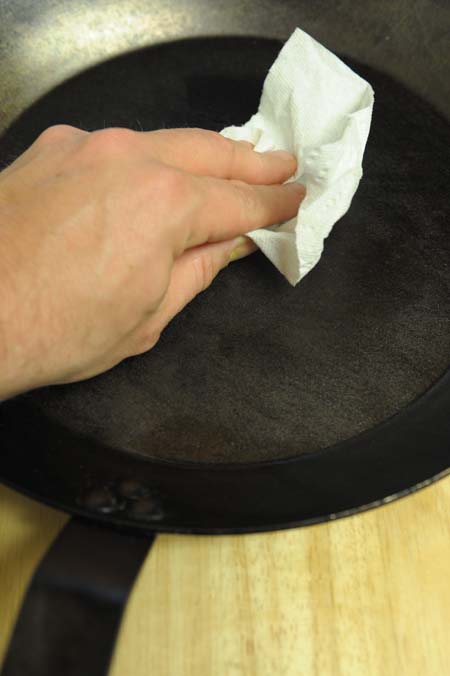
These three tricks make cooking with cast iron nearly nonstick:
- Always cook with enough oil – don’t try to skimp
- Let the oil heat up prior to adding the food that needs to be seared or fried. Too low of a temp may cause sticking.
- Let the food cook all the way on one side before turning – this is especially true if you’re cooking something breaded. Once it reaches the correct level of “doneness,” it will release from the pan.
Coarse Salt Method
The traditional way of removing burned on food is by using a mild abrasive, such as coarse kosher salt.
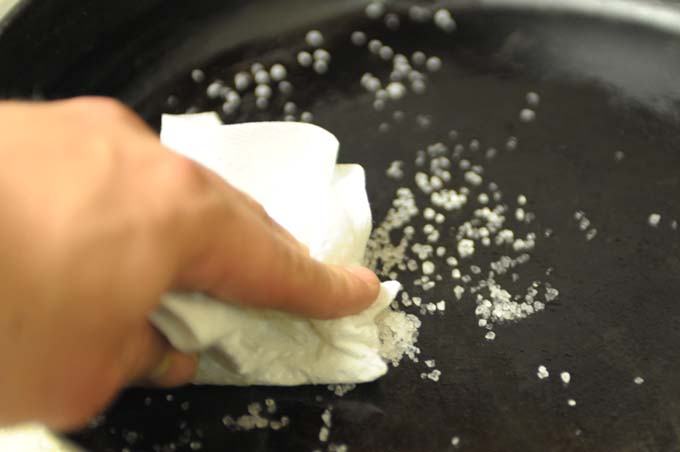
Here’s how it works:
Leave some of the old oil in your warmed skillet. Then take a folded towel and scrub the pan with the salt. You may want to grab the towel with a pair of gloves or tongs if your pan is still too warm to touch. Scrub all surfaces with the salt/oil mixture until all the food residue is gone. Dump the salt out of the pan and rinse with hot water. Dry thoroughly and coat with a layer of oil before storing.
Stainless Chain Mail Scrubbing Pads Method
I have found that these products are the absolute best way to clean cast iron and carbon steel skillets, and other assorted cookware. Heck, they even work well for removing burnt food that’s stuck on stainless steel and clad pots and pans.

The Ringer Cast Iron Cleaner XL 8×6 Inch Stainless Steel Chainmail Scrubber is the perfect tool for keeping your cast iron pans clean, while maintaining the natural nonstick qualities achieved with frequent seasoning.
This detergent-free alternative will not only clean your cast iron pans, but all of your kitchenware as well. The chainmail works great without the mess or residue of steel wool. It is abrasive enough to remove stuck on food as well as rust.
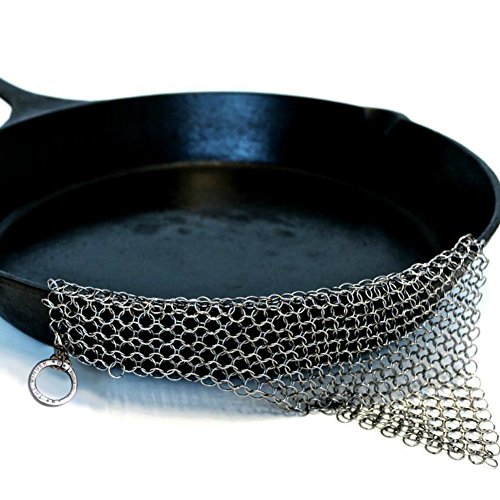
The Ringer Cast Iron Cleaner XL 8×6 Inch Stainless Steel Chainmail
For optimal results, rinse the pan with hot water or use a non-metal brush or chainmail scrubber immediately after use. Scrape out any large pieces of cooked on food. If it is really baked on, you can try adding some hot or boiling water to the pan to help loosen it.
I find that I usually only need a gentle touch with the Ringer and any stuck on food is removed. This includes black burnt-on carbon on the bottom of stainless steel pots, which you normally spend eons trying to remove with a combination of S.O.S. pads and/or a butter knife. With the Ringer, this can be reduced down to a 10- or 20-second chore.
Everyone should own one or two of these chainmail scrubbers – they are that good. I am so impressed by their performance and ease of use that I often purchase them to give to friends and relatives. Read what others have to say about the Ringer XL on Amazon.
Heated Water/Soap Method
The next best thing to clean your cookware with is the universal solvent – water. Heated water or even boiling water can normally remove even the most stuck-on proteins. It’s simple technique – meanly added the water to skillet and turn on the stove. Scrape with a spatula or spoon if required, or use a green scrub pad to (lightly) remove gunk.
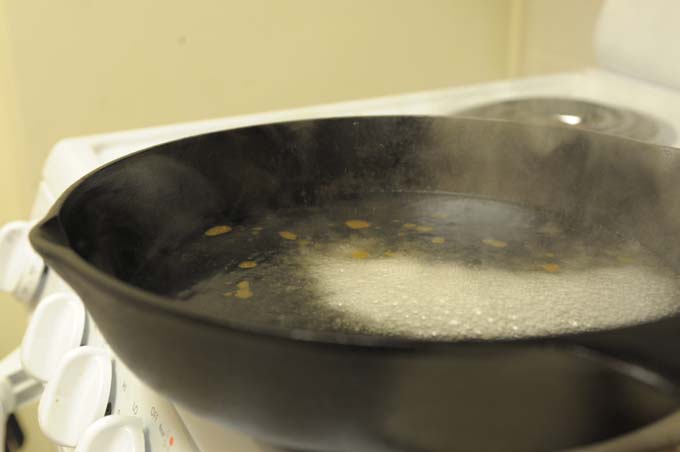
If you have a well-seasoned pan (and I mean well-seasoned), you can try using a few drops of dishwashing soap as a last resort. Even though soapy water is allowed on your first washing, and then on the (perhaps) rare occasion, never put your pan in the dishwasher – bad things happen (not quite as bad as what happens after spilling water on a Mogwai, but bad nonetheless).
Drying and Rust Prevention
To prevent rust, always dry your pans thoroughly after cleaning. If you do not completely dry your cast iron pan after each use, it will be prone to rust.
After patting dry and placing it in the oven to remove all moisture, lightly coat the cooking surface with vegetable shortening, lard, or vegetable oil and return to the oven for ten more minutes.
You can also dry the pan out on the stovetop. If you use this method, once the pan is dry, pour a small amount of cooking oil, shortening, or lard into the pan. Using a dish towel, rub the oil into the surface of the pan. Wipe to remove any extra grease, and cover the cooking surface with a paper towel before storing.
Storing Cast Iron
Store cast iron in a dry area. Remove lids to prevent rust from forming. If you’re not going to use them for a while, remember to make sure that they have a coat of oil wiped on – vegetable oil will do, but you may consider food-grade mineral oil instead if they are being placed into actual “storage,” as it won’t go rancid (i.e. oxidize and create nasty flavors).
Don’t panic if you haven’t used a pan in awhile and it feels sticky. This is just some of the surface oils starting to polymerize (similar to way they solidify during the seasoning process). You will want to remove most of this old grease since it is likely rancid, and may leave a foul taste in your food.
It’s really easy to remove these congealed oils – simply wipe the surface with a vegetable oil soaked paper towel or dishrag. Try to remove as much of the stickiness you can, using some elbow grease. If you can’t get it all of it, don’t worry. Leaving a little on won’t hurt – it’ll cook out.
If your pots or skillets have rusted, then you’ve got a more serious issue. A light surface rusting can be removed using Brillo or a green scouring pad and some water, or better yet, with the aforementioned Ringer XL stainless steel chainmail scrubber. The vessel should then be dried and oiled immediately. However, if the rust goes much further than that, it’s time to bust out the steel wool, vinegar, and other accoutrements, and begin the seasoning process over again.
With proper seasoning and care, these pans can be passed on from generation to generation, maintaining their natural nonstick qualities for years.
About Jennifer Swartvagher
Jennifer is an experienced journalist and author. Her work has been featured on TODAY Parents, The New York Times Blog, BlogHer, Scary Mommy, and scores of other parenting and cooking publications.

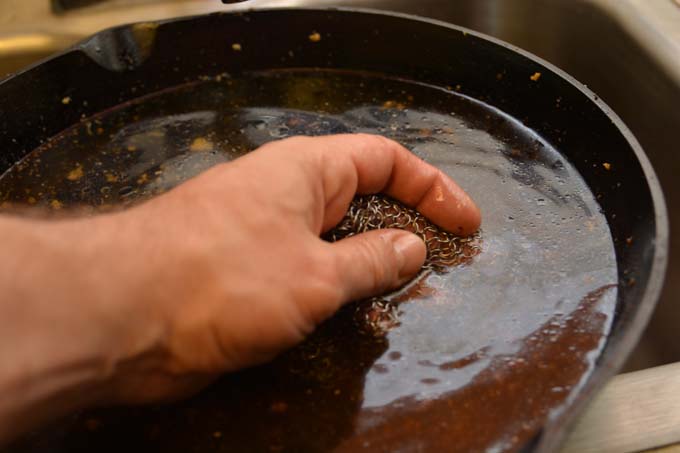
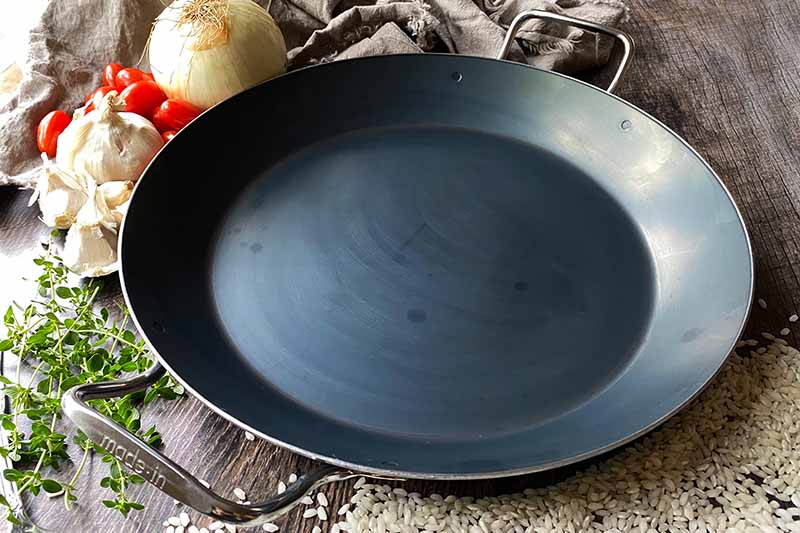
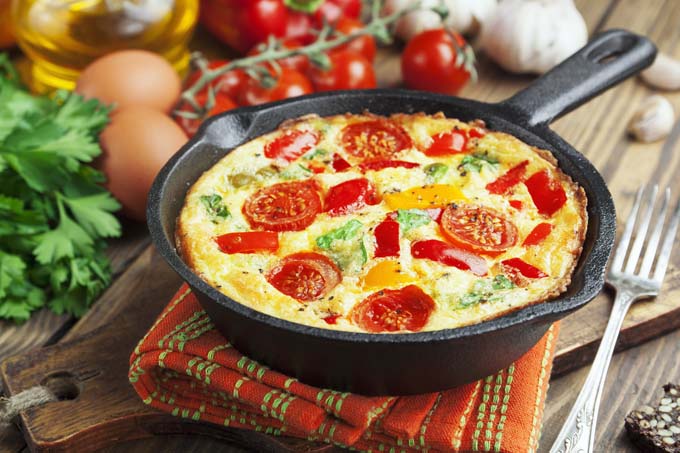
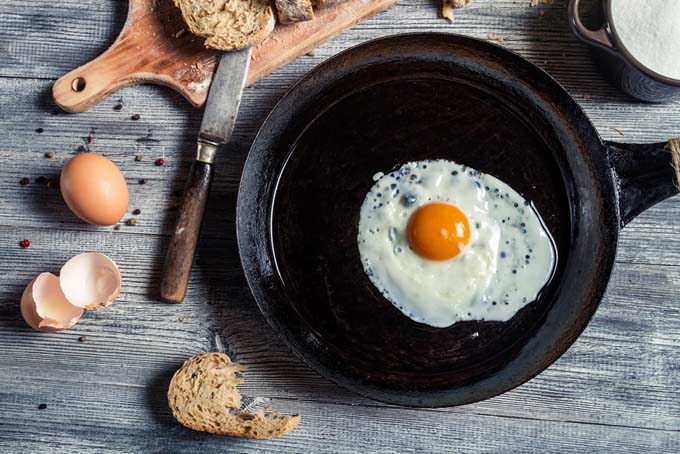
I just love my cast iron skillet! I use it almost exclusively to cook cornbread in using my mom’s recipe. I really find these cleaning methods helpful. I have heard of the salt method before but haven’t tried it – I’ll use next time I’ve got something stuck on. The chainmail method is something I’ve never heard of either, and I’m very intrigued by it. I’m thinking now that I’m going to have to buy some and try it out (if all else fails I’ll buy a couple extra and make suit for the next time I have fight a dragon!). Thank you for writing this article! It will also be very helpful for beginners as well as those who are a little more familiar with cast iron.
Cast iron skillets are so nice! I got gifted one by my best friend for my birthday and I love cooking with it! It’s vital in my kitchen now.
I have been using the salt method everytime I clean it but I’ll try one of your methods, they seem to do the trick better!
Some great tips here, thanks. I love to cook steak on my cast iron pan as well, but never had any real clue how to clean it properly (up until today I just cleaned it like any other cookware). I will keep these methods in mind next time.
I made the mistake of soaking a cast iron pan when I was helping out as a volunteer in a kitchen as I had never used cast iron before. It is hard work cleaning them, but once you know how it’s fine, but at first the thought of cleaning them put me off using them. I like the idea of using salt, because I don’t like the sticky feel that is left behind.
Excellent article. I do some of the steps, but now I can do an even better job. This is just in time too. I seared some steaks for dinner last night, and I hate to admit it, but I didn’t clean the skillet right away. I’m going to try warming it and using the salt method. I’ve heard of using salt for other cleaning stuff but not for this, so this is a handy tip.
Cast iron can make such a difference in cooking that I think it’s definitely worth the extra effort.
I don’t have much experience with using cast iron skillets – I dodn’t really know too much about them and had no idea that they would provide a non-stick surface witht he correct maintenance. Revisiting Lynne’s article has inspired me to seek a pan or two out at yard sales.
I like the coarse salt method because it’s the closest to a natural clean I can get on my cast iron items. I’ve always heard using soap or scrubbing the cast iron is a bad bad thing. So I try to avoid that at all costs.
I love my cast iron skillets but I’m always afraid I’m going to ruin them in someway when I clean them. I really like the coarse salt tip. I will definitely give that a try next time I have something stubborn sticking to the pan!
I really like cooking with my cast iron also. I have one particular pan that is in need of a deep cleaning as the finish has started coming off. I tried scrubbing with an abrasive wool pad, but that did not work. I will try to find a chain mail cloth, as it looks like that will work much better and faster.
This is such an entertaining and enlightening article. I grew up in a household where the only cooking utensils used were cast iron. I never did much cooking, so I never really learned to take care of it. My mother always had beautiful well-seasoned cookware. When I got my own few pieces, I had no idea how to clean it. The salt method is invaluable, as is the mail glove. My daughter has been asking me to buy some new pieces. I think I’ll give it another try.
I’ve been using cast iron pots and pans for several years now. I have soaked them, and even restored from complete rust orange. ( purchased at yard sale). I have always felt a little odd leaving dirty oil in my pans once I’m done with the cooking process. I typically use a natural soap product on my dishes, Cast Iron included. The only method I have followed over the past 25 years is to add oil, usually coconut or soybean, once I have cleaned and thoroughly dried my pans in order to protect them from the moisture of everyday life. So far, I haven’t noticed any deterioration or oxidation due to water and rust.
A very informative article. I came from a farm background ,grew up in the fifties, all we used were cast iron frying pans.
I would just like to add another cleaning method, which I employ camping or horse packing, etc. Sand works very well for cleaning your pan. It will get rid on the most stubborn “stick ons or mistakes”, and a nice light smear of your preferred oil afterwords, it is good to go again.
Thanks, again for your article, it brings back many memories of cast iron cooking.
Regards.
I had to come back for a refresher course. Maybe it’s just me, but my skillet just doesn’t seem clean. I think I may need to start the process all over.
I appreciate all the great tips. I’ve started to love using these pans.
Thanks for the great tips! I see now that I’ve actually not been so smart with my iron cookware. I just wash after use with soap and water and then dry it quickly to prevent the rust. I haven’t bought new ones in a while. With your list here I think I can safely invest in a new bunch and protect them from damage! It’s wonderful the things you can create with an iron skillet.
My wife and I always loved camping when we were first married. It’s been a while since we’ve gone, but now that our kiddos are getting older we’re looking into buying some nice camping cookware that can feed the family. I like what you said about how, with proper care, cast iron pans can last long enough to pass on to your children. I love the idea of buying quality cook ware, using it as my kids grow up, and then being able to pass it on to them.
Would love to hear about caring for the outside of the pans. I’ve seen people say you rub oil on the exterior but isn’t that a fire risk?
I am not a fan of the salt method…seems corrosive.